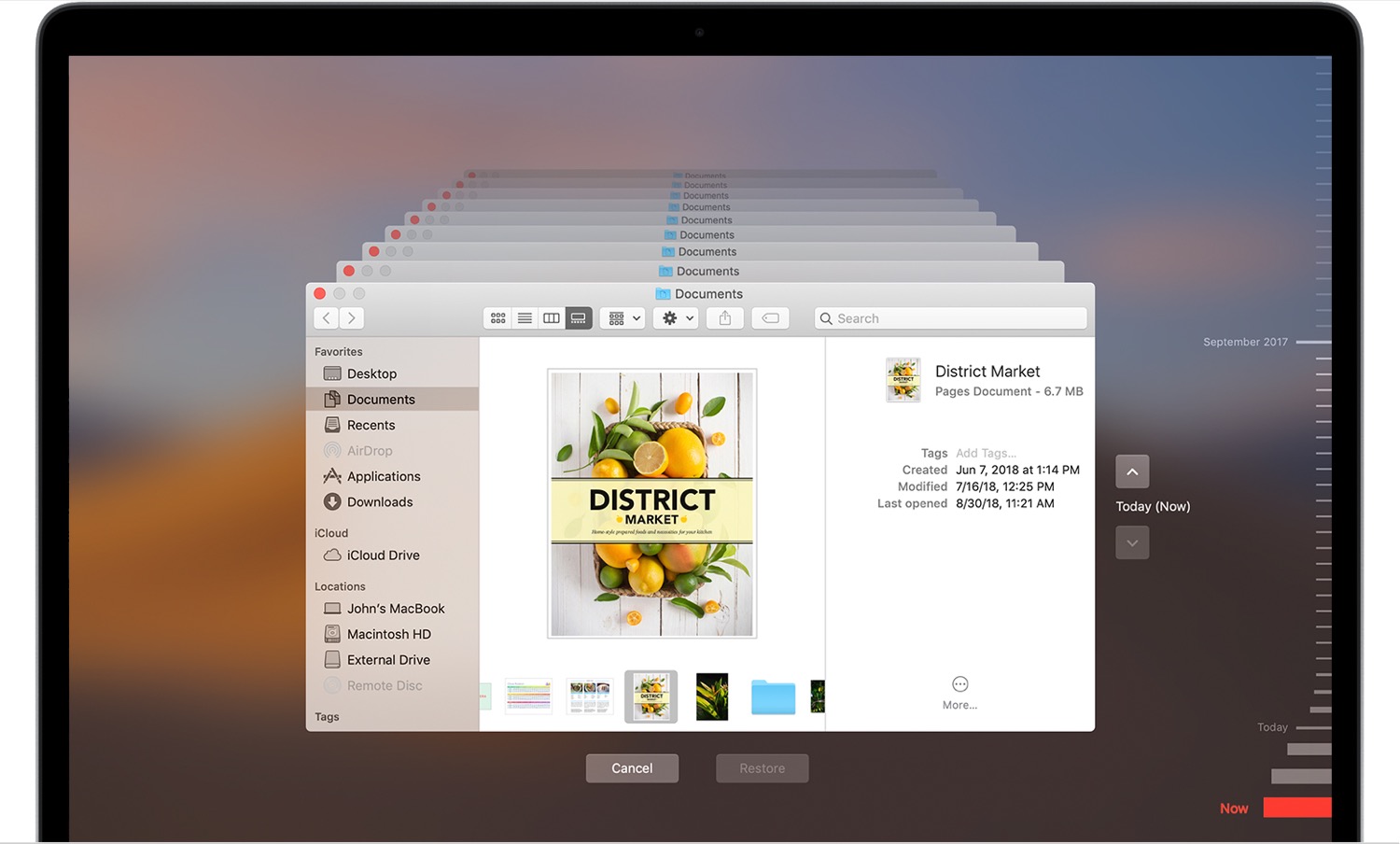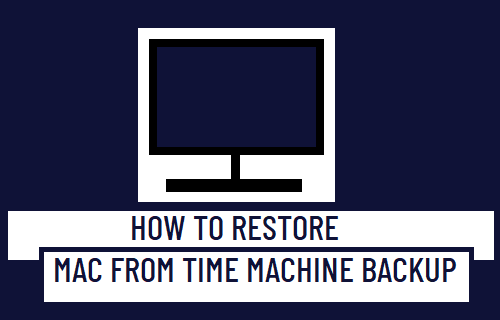
- #Mac time machine restore operating system how to#
- #Mac time machine restore operating system install#
- #Mac time machine restore operating system manual#
- #Mac time machine restore operating system archive#
- #Mac time machine restore operating system pro#
Go to System Preferences > Time Machine. With Time Machine, you’ll always need a new formatted drive to “force” an unplanned backup, though. #Mac time machine restore operating system how to#
You can consider backing up to cloud (we’ll explain how to backup Mac to iCloud and external cloud services in a moment), but a safer solution is to backup to external drive, for sure. Just select the backup in the left bar menu and click Restore.
#Mac time machine restore operating system pro#
And that device shouldn’t necessarily have Get Backup Pro installed on it! So it’s really easy to pick up where you left off. With Get Backup Pro, you can restore your backup to any device. Remember to keep your external drive or SSD connected to Mac when you’re restoring from Time Machine backup. To retrieve a file from a Time Machine backup, you should open it from Spotlight, locate the file you want to restore, click the Cloud icon to download it, and click Restore. For example, if you want to restore all the data from backup on a new Mac, you’ll see this option in Migration Assistant. How to “unpack” those files you’ve backed up? With Time Machine, the process of restoring data is in many ways connected with other system processes.
#Mac time machine restore operating system archive#
You can also do many more things - archive your backups, create a schedule of automatic backups, sync folders, etc.
#Mac time machine restore operating system manual#
This is the most basic manual backup process with Get Backup Pro.

 Click ‘File+’ or ‘Apps data+’ to add the data you want to back up. Click the plus button to create a new project. Open the app and select ‘Backup’ or ‘Clone’ (yes, Get Backup Pro can also do a bootable clone - a mirror of your boot drive). Here’s how to back up Mac with Get Backup Pro: Let’s just say you’ll save a lot of storage space on your drive by using this app. The level of compression is 60% better than with Time Machine. Unlike Time Machine’s automatic backups, you can control the backup schedule with Get Backup Pro.īest thing, Get Backup Pro in fact asks you which files and folders you want to backup, so you can backup only the most essential stuff. Get Backup Pro is a Time Machine alternative that does a much better job - protecting data while also protecting your storage space. And since you can’t control the backup schedule with Time Machine, it all gets…complicated. Plus, Time Machine will routinely backup everything on your Mac - you can exclude certain files from the backup, but the process is very tedious and you’d have to do it manually every time. The problem with Time Machine backups is that they are poorly compressed, which means they occupy too much more space. Optionally, select ‘Show Time Machine in menu bar’ - it will help you keep an eye on the progress of your backup. Follow the prompt to ‘use this drive with Time Machine,’ or go to System Preferences > Time Machine > Select Disk. Connect an external hard drive or SSD to your Mac. Here’s how to backup Mac with Time Machine: As long as there’s storage space, the hourly, weekly, and daily backups will routinely pile up and then get replaced with the new ones - that’s how it works. It’s a native tool designed to automatically backup Mac at specific time intervals. How do I back up my Mac? If you ask Apple, Apple will advise you to use Time Machine. For example, you can use a backup to quickly move data to a new Mac and access it on another device if you’re away from your Mac. While we mostly focus on bad scenarios when we talk about backups, there are also many ways in which they can benefit your workflow.
Click ‘File+’ or ‘Apps data+’ to add the data you want to back up. Click the plus button to create a new project. Open the app and select ‘Backup’ or ‘Clone’ (yes, Get Backup Pro can also do a bootable clone - a mirror of your boot drive). Here’s how to back up Mac with Get Backup Pro: Let’s just say you’ll save a lot of storage space on your drive by using this app. The level of compression is 60% better than with Time Machine. Unlike Time Machine’s automatic backups, you can control the backup schedule with Get Backup Pro.īest thing, Get Backup Pro in fact asks you which files and folders you want to backup, so you can backup only the most essential stuff. Get Backup Pro is a Time Machine alternative that does a much better job - protecting data while also protecting your storage space. And since you can’t control the backup schedule with Time Machine, it all gets…complicated. Plus, Time Machine will routinely backup everything on your Mac - you can exclude certain files from the backup, but the process is very tedious and you’d have to do it manually every time. The problem with Time Machine backups is that they are poorly compressed, which means they occupy too much more space. Optionally, select ‘Show Time Machine in menu bar’ - it will help you keep an eye on the progress of your backup. Follow the prompt to ‘use this drive with Time Machine,’ or go to System Preferences > Time Machine > Select Disk. Connect an external hard drive or SSD to your Mac. Here’s how to backup Mac with Time Machine: As long as there’s storage space, the hourly, weekly, and daily backups will routinely pile up and then get replaced with the new ones - that’s how it works. It’s a native tool designed to automatically backup Mac at specific time intervals. How do I back up my Mac? If you ask Apple, Apple will advise you to use Time Machine. For example, you can use a backup to quickly move data to a new Mac and access it on another device if you’re away from your Mac. While we mostly focus on bad scenarios when we talk about backups, there are also many ways in which they can benefit your workflow.  You can keep access to your files after some ransomware or any type of malware hits your Mac. They save your data if your drive suddenly fails, or there’s any kind of unexpected software or hardware issue. They help get your files back if you lose your Mac or someone steals it. Here’s a quick list of all the reasons why backups matter: A backup will help you restore all the files for when you fix your Mac or get the new one. Maybe it just suddenly goes black screen one day, you spill a cup of coffee on it, or else. Backups should be part of your digital life permanently because they guarantee quick file recovery, no matter what happens to your Mac.
You can keep access to your files after some ransomware or any type of malware hits your Mac. They save your data if your drive suddenly fails, or there’s any kind of unexpected software or hardware issue. They help get your files back if you lose your Mac or someone steals it. Here’s a quick list of all the reasons why backups matter: A backup will help you restore all the files for when you fix your Mac or get the new one. Maybe it just suddenly goes black screen one day, you spill a cup of coffee on it, or else. Backups should be part of your digital life permanently because they guarantee quick file recovery, no matter what happens to your Mac. #Mac time machine restore operating system install#
It’s absolutely necessary to know how to backup your Mac if you ever update macOS, especially if you install betas, which are often unstable and can cause accidental data loss. Also, we’ll recommend the best tools to backup Mac fast, without wasting tons of storage. In this guide, we explain how to backup Mac to external hard drive, when you’ll need a bootable copy of your drive, and how to schedule regular backups.







 0 kommentar(er)
0 kommentar(er)
